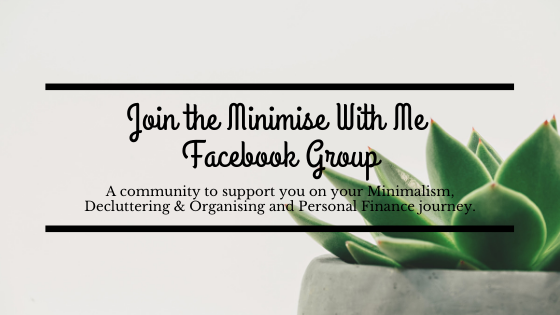When I first started decluttering our home I knew I had stumbled onto something amazing. It was what I looked forward to when I came home from work each day. With each freshly decluttered drawer, shelf or cupboard I felt a sense of accomplishment and slightly less overwhelmed.
I started with my own belongings; my wardrobe, shoe collection, make up, toiletries and accessories. Soon enough I was ready to move onto other areas of the house. I knew it was something I saw the need for, but also knew that it was not going to be so easy to convince my husband.
I spoke to my husband about this new lifestyle I had came across, Minimalism and living a more intentional life. Luckily he didn’t baulk at the concept and was okay with me decluttering our home as long as I didn’t touch his items.
After a while, I approached him about his wardrobe and if he would be okay with getting rid of some of his excess shirts that had seen better days. To my surprise, he was mostly willing to let go of everything. We continued to tackle the ‘easy stuff’ until one day after months of my own decluttering, he asked me to help him go through his personal space.
Over the past three years, we managed to declutter over 70% of our unwanted possessions. That was made a whole lot easier thanks to my husband being on board with this journey. Of course he didn’t start off donating baskets of items and yelling out ‘Let’s be Minimalists’, (although that would be pretty hilarious). But over time and with lots of understanding and communication, he saw – as I had, the value being added to our lives by letting go of the excess so we could enjoy what was essential.
We could find our stuff, we could close our drawers without a struggle, we had space and empty cupboards – shock horror! And most life changing was probably the fact that now as we were bringing less into the house, we saved money.
It was trial and error over that period to learn how to help someone else acknowledge the benefits of letting go of unwanted items just as I had. Through my decluttering process and working with my husband over time, I learnt some valuable lessons along the way that might help you get your family on board with decluttering and you working as a team, rather than facing and uphill battle.
Here are 10 Tips to Help You Get Your Family On Board With Decluttering.
1. Lead by Example
When was the last time you ever made a change in your life because someone told you to? If someone told you to stop eating chocolate would you jump on board that day? Or, would you be more likely to jump on board if you saw a family member or friend decide to do a chocolate free challenge and join in after seeing that they’d lost weight from doing that challenge? Some times we need to watch form the side lines before we can be willing to jump into something new.
If you want to get your family on board with your decluttering journey, rather than telling them what they have to do, why not lead by example. Start working on your own cluttered spaces. Declutter your wardrobe, your shoe collection, your own toiletries or beauty products, hair accessories, your DVD collection. When you partner or children, (or room mates if you have them) see your progress and how great your spaces are looking they will be a lot more willing to start decluttering their own space, or at least be more on board with you decluttering communal spaces like living and dining areas.
2. Communicate with with them
In order to help get your family on board with decluttering ask yourself why you want to declutter your home? you need to know your why so you can help communicate that message with them. Are you feeling stressed trying to keep things clean with your kids toys everywhere? Can you not keep up with the laundry because there are endless clothes strewn around and in the laundry pile? Do you find it hard to focus on anything when you have clutter piling up around you? Talk to your family about yours needs and why you need to declutter your space. When they hear your struggles and reasons for letting go of things, they may be more willing to help you and get on board. It may even spark them to think of their own reasons to declutter and how the process could help them.
Related Post: 101 Things You Can Declutter in Your Home Right Now
3. Set a common goal to work towards
In order to get your family on board with decluttering and encourage them to adopt a less cluttered space, find a communal why. Maybe it’s the fact that by selling your unwanted stuff you can make some money to go on a family vacation. Perhaps your children will be on board when they learn how donating their old toys can help other less fortunate children. How about a goal of downsizing your stuff so you can move into a smaller home which will enable you and your partner to work less hours, spend less time and money on house maintenance and have more time to spend doing things you enjoy together? When you both have a clear goal in mind it can make the process much more successful and help others see the benefits.
4. Clear the excess to make room for the essential
When you have too much stuff, we can forget what is really important to us. Have you ever gone through and decluttered your wardrobe and realised that you had misplaced an old favourite outfit and completely forgotten about it? Maybe your favourite lipstick was lost in a sea of 20 other ones or you forgot about your favourite books because you didn’t notice them on the shelf next to the 200 other books that you have.
When we clear the excess we can make room for the essential. We can curate a wardrobe we love, we can keep the books on display that we enjoy reading over and over again, we can display things around our home that bring us joy. When we have too much stuff we lose site of the stuff that adds value to us.
If your kids have too many toys they won’t have the time or attention to play with something fully. Maybe your spare room is filled with crap, rather then used as a room that is more useful such as a theatre room or studio. Or you have so many CDs or DVDs stacked on top and in front of one another that you can’t even see what you have and end up not using the ones that you do love as they are lost behind the excess. When the excess is gone, we can enjoy the things we truly love.
Related Post: 7 Essential Questions to Help You Declutter Your Wardrobe
5. Be respectful of their zone
When on your decluttering journey be sensitive to your loved ones areas. You won’t be able to get your family on board with decluttering by attacking them and insisting they get rid of their stuff. Let them have their own designated space for what they find valuable. It may not be valuable to you but that doesn’t mean it is not to them.
Maybe their zone is the spare room they can set up as they wish, or a corner of the garage, or a desk in the house. Let this space be their sanctuary to keep what they please. Of course they will need to keep their stuff in the confines of the space, so once they fill their space they will need to remove something before they can bring anything new in. This will keep your partner or family happy, but also give you the ability to keep the spaces that you share less cluttered.
6. Help them
Sometimes your family may be on board with decluttering but don’t know where to start. Or aren’t quite sure of the benefits just yet. A great way to get them on board with decluttering is to offer them help them.
Be specific if possible to help your loved one recognise the need for your help. If you can see your child frustrated with their toys being everywhere that might be the time to offer to help them with them decluttering their toys so they have space to play. Or if you see your partner struggling to find their favourite shirt, that week might be a good time to discuss that issue. You could say something along the lines of ‘I noticed that you were struggling to find your shirt the other day in your wardrobe, would you like me to help you go through your cupboard and see if there is anything we can clear out to make space for the items you love?
Of course, if they decline, don’t force it on them. But hopefully you have planted a seed that they will consider and in time they might be more willing to come around and ask you for help when they are more open to to removing the excess.
Related Post: The True Cost of Our Stuff
7. Start small
Don’t expect your loved one to let go of their most treasured items from Day One. Start small and work your way up. Build their and your decluttering muscles gradually. Start with the stained and torn shirts. The damaged shoes, expired items and anything broken. Get rid of duplicate items around the home or anything that you both agree can go. Save the harder stuff for later when you are more experienced with decluttering and more knowledgeable on what does and doesn’t add value.
8. Make it fun
Decluttering doesn’t have to be boring and tedious, why not make a game out of it! Try The Minimalists Mins Game where you declutter one item on day one, two on day two, three on day three and so on. Or do a Packing Party. Another fun options is to make a simple challenge to see who can declutter the most items at the end of the week. Check out the Minimise With Me 31 Day Decluttering Challenge for one with daily challenges for you.
9. Make it a habit
Decluttering isn’t a once off event. Over time things can creep back into the home with Christmas, Birthdays, events, anniversaries and so on. It is something that needs to be reviewed as you go. Make decluttering a habit. You could do a seasonal declutter such as when Spring hits or bi-annually. Or simply leave a container in the bottom of your families closets so they can declutter items as they go, and empty their bins when they get full.
Make some new traditions such as donating unwanted toiletries and a bags to a local Charities Christmas or Winter Appeal. As you approach Christmas, ask your children to fill a bag or container with toys they want to donate to less fortunate children for Christmas. Let them know that they will need space for any new toys Santa is bringing and make a habit each Christmas for them to go through and select some toys they no longer play with to be donated.
10. Implement a one in one out rule
A good place to start is to try and stick to a one in out rule. Make a suggestions as new things come into the house. Is your partner getting a new laptop or electronic? Maybe they could sell the old on (Less clutter and money? Win!). This would also help offset the cost of the new one.
After a while this will become second nature and can help limit excess clutter entering the house, as only the things your family truly values will come into the home if they are going to have to let go of something else in order to bring it home with them.
What tips did you find helpful to get your family on board with decluttering? Were they on board from the start? Or got you on board? Or maybe it took some time but you eventually won them over? Share your experience in the comments below 🙂
[Photo by Priscilla Du Preez on Unplash.com]









